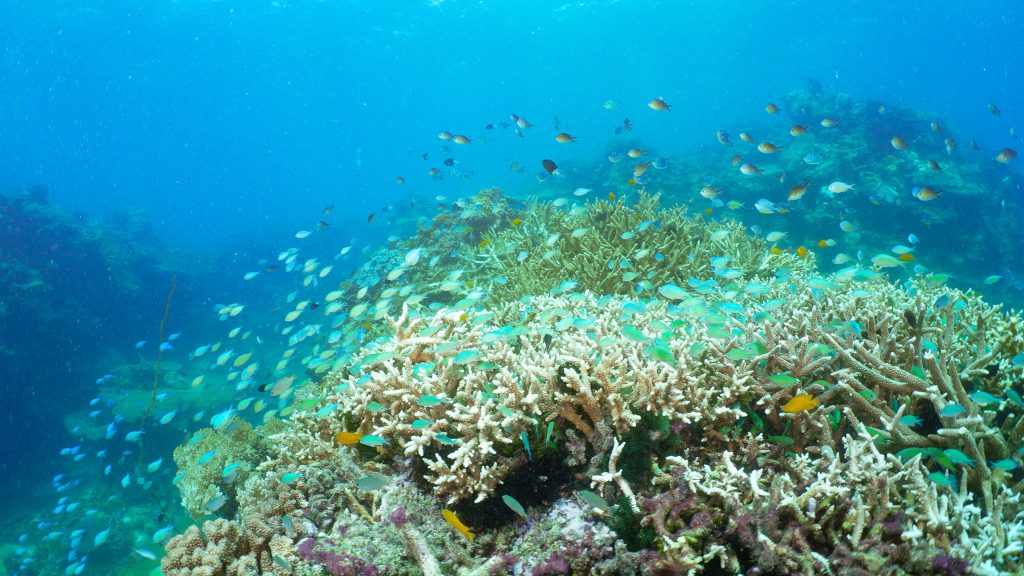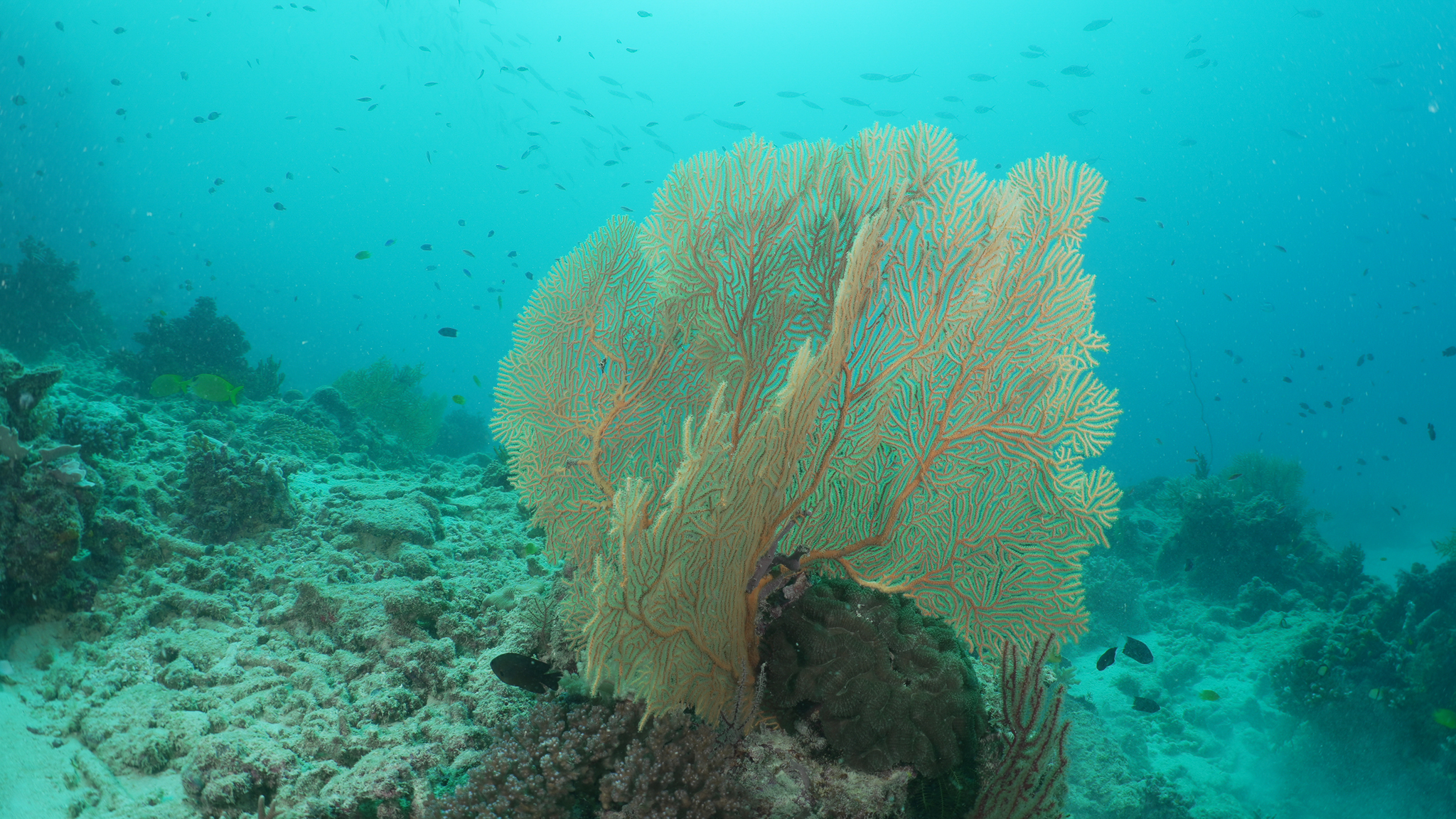There used to be crevasses overlaid with large pink plate corals just beyond the boat where you jump off into the lagoon at John Brewer reef, and so I never made it around to the reef front proper – at least not down the sandy front to a depth of 22 metres.
I was there last Thursday, at the reef front and I was mesmerised.
(I hope you are reading this on a large screen, so you can see the detail when you play the clips/the few frames.)
So many soft corals, especially Gorgonian fans in shades of purple and gold, feather stars, and fish, and more fish – so many little fishes in every shape and colour.
I was disappointed in my buoyancy on both dives at John Brewer reef last Thursday; it seemed to be all over the place. The secret I’m told is to be calm.
Then again, how is one to keep calm when everywhere that I looked there was something more spectacular, than what we had just swam past!
More spectacular. And when it came to the Jointed Razorfish (Aeoliscus strigatus) they were swimming on their heads. And I was meant to stay calm.
There is no relief. Even now. When I close my eyes: I see fishes.

*******
The photograph at the top of this post, and the three clips are, of course, by the perfectly calm Stuart Ireland filmed at John Brewer Reef on 4th April, 2024. So much thanks to our guide, Paul Crocombe who is a PADI Master Scuba Instructor, and a Master Reef Guide and the owner of Adrenalin Dive.


 Jennifer Marohasy BSc PhD is a critical thinker with expertise in the scientific method.
Jennifer Marohasy BSc PhD is a critical thinker with expertise in the scientific method.

Beautiful video , the watcher could certainly be calm and lost in these videos, thank you such beauty.
“Dr Selina Ward, a marine biologist and former academic director of the University of Queensland’s Heron Island Research Station, said it was the worst bleaching she had seen in 30 years working on the reef, and that some coral was starting to die.
The Great Barrier Reef Marine Park Authority last week said aerial surveys of more than 1,000 individual reefs revealed more than half were rated as having high or very high levels of bleaching, and a smaller number in the south – less than 10% of the total – had extreme bleaching. Only about a quarter were relatively unaffected.
It confirmed the 2,300-kilometre reef system was experiencing its fifth mass bleaching event in eight years. The authority said sea surface temperatures had been between 0.5C and 1.5C hotter than expected for this time of year.
The Australian Marine Conservation Society on Thursday released video and photos that it said showed bleaching on the southern part of the reef extended to greater depths than had been previously reported this year.
Ward said the impact of bleaching had been extensive across 16 sites that she visited in the reef’s southern section, affecting coral species that had usually been resistant to bleaching. Some coral had started to die, a process that usually takes weeks or months after bleaching occurs.
“I feel devastated,” she said. “I’ve been working on the reef since 1992 but this [event], I’m really struggling with.” – The Guardian
“Aerial surveys conducted over the Great Barrier Reef have been completed and confirm widespread bleaching across all three regions of the Marine Park.
The surveys conducted by the Reef Authority and the Australian Institute of Marine Science assessed more than 1000 individual reefs, including 836 reefs in the Marine Park and 244 reefs in the Torres Strait region.
Of the reefs surveyed by air in the Great Barrier Reef Marine Park:
A quarter of individual reefs surveyed recorded no to low levels of bleaching. This included reefs in the far north, along the outer shelf north of Port Douglas and north of Lockhart River where less bleaching was observed.
Half recorded high or very high levels of coral bleaching. Very high bleaching was found on many of the inshore reefs in the central region of the Marine Park. Several mid-shelf reefs from Innisfail to Cape Melville, including the Lizard Island region, were also affected by very high and extreme levels of bleaching.
Less than 10 per cent had extreme levels of coral bleaching. High to extreme levels of bleaching were common in both offshore and inshore reefs in the southern region of the Marine Park.” – https://www2.gbrmpa.gov.au/learn/reef-health/reef-health-updates
It seems to me that there is a scare campaign going on here. The GBR has always suffered from storms and cyclones, yet regenerates over time. The past few years of slightly warmer sea temps and lack of cyclones seem to have allowed the reef to regenerate to such a degree that the GBR has been described even by the Marine Authority as being in great shape, indeed, best ever. It is not surprising that there may be extensive coral bleaching due to damage from recent storms. The corals in protected areas have remained undamaged, as Jennifer has shown. The cycle of regeneration will obviously continue in the future. This is how nature works.
Appears quite a bit of scare mongering going on with the average person probably accepting what some of the so called researchers and institutions are trying to put across, Dr Selena Ward … would you like funding with that 🙂
Aargh. The sky must be falling..
Frankly I’ll take the word of someone who actually goes down below the surface to look. Aerial photos can be be misleading, and the action is out of sight. As Jennifer has shown.
I love those vertical guys, “swimming on their heads”. People look at me as if I’m crazy when I tell them the GBR is doing well, and where to look for evidence. Getting accustomed to that these days.
Thanks for the footage. Lovely stuff.
Yeah, why trust climate scientists who have trained for years to understand the full implications of all this silly climate stuff! Better to trust bloggers who occasionally go swimming in tourist-approved spots.
https://heated.world/p/the-only-way-to-save-coral-reefs?utm_source=post-email-title&publication_id=2473&post_id=143678958&utm_campaign=email-post-title&isFreemail=true&r=jk9nk&triedRedirect=true&utm_medium=email